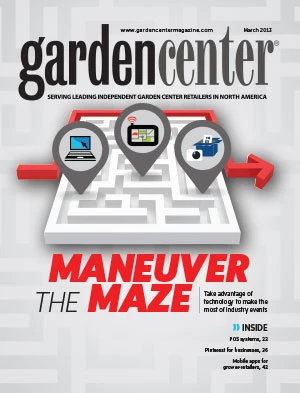
 If you read all the trade magazines, you’ve no doubt come across many articles telling you to use a point of sale (POS) system in your garden center. You’ve probably also seen features on the different models and comparisons of pros and cons. They are right — you do need one, and there are many different options to fit different needs. But when I was asked to write about POS systems in the garden center, I decided it might be more helpful to offer my perspective as an employee-user, rather than profile actual systems. As the general manager for North Haven Gardens in Dallas, Texas, for eight years, I’m not sure how I would have done my job without a POS system. Or at least, I’m pretty confident I would not have been able to run the business as successfully without the use of one.
If you read all the trade magazines, you’ve no doubt come across many articles telling you to use a point of sale (POS) system in your garden center. You’ve probably also seen features on the different models and comparisons of pros and cons. They are right — you do need one, and there are many different options to fit different needs. But when I was asked to write about POS systems in the garden center, I decided it might be more helpful to offer my perspective as an employee-user, rather than profile actual systems. As the general manager for North Haven Gardens in Dallas, Texas, for eight years, I’m not sure how I would have done my job without a POS system. Or at least, I’m pretty confident I would not have been able to run the business as successfully without the use of one.
If you’re driven, sales-focused, and intent on improving your business, how can you possibly hit your targets if you don’t know where your sales stand and what you have on hand? This for me is the central question when it comes to using or not using a POS. Yet, I regularly run into garden center owners that have not invested in one. Perhaps not using a POS works for you if you run a very small business and can touch your entire inventory with out-stretched arms. If that’s not the case, you may not know what you’re missing … literally. If you’re still not sure how or why a POS could benefit your business, here are a few ways I relied on one to generate real profit.
Keep a tight rein on your inventory to increase efficiency
Turns are a key component to making a profit in a retail garden center, especially with live goods. When you have real people doing the day-to-day buying in your garden center, they need tools to efficiently manage their inventory. Having a POS meant I could at any given moment see live inventory levels for every piece of merchandise on the five acres I managed. It also meant that buyers, and any floor staff with access to a register, could look up on-hand quantities for requested material or turn in a re-order request.
The buyers and I could run reports to see how many Pittosporum ‘Wheeler’s Dwarf’ we had in-stock, when we’d last received them, which vendor we bought them from and how many were on order — or not on order. That information allowed us to manage current stock and existing bookings, move order dates and adjust quantities based on demand and weather. All with the goal of increasing turns by meeting customer needs and identifying trends.
Preventing loss is also a big factor in your turn rate. The POS allowed me to track discrepancies between what I’d ordered, what sold and what was missing. Sure, we all have write-off policies, and in a perfect world each one is documented; but we all also know that not all our staff is going to write off every plant they pitch into the compost pile. I used our POS to keep an eye on slippage and could then work with staff to identify the problem, be it a maintenance or merchandising issue, lack of demand or poor promotion.
Learn from your sales history for a profitable future
Running detailed sales reports for departments, categories or sub-categories, by date range, customer and vendor was a crucial part of my day-to-day as general manager. Our POS allowed me to run reports using a pretty hefty list of filters. I probably sounded like a broken record to my buying staff because every time they’d ask me “how many of these do you think we can sell?” my answer was always the same: “Well, did you run sales reports to track the sales history?” These reports are a really powerful tool when it comes to accurate buying and selling.
 POS systems can allow staff to quickly access inventory and sales history. Wavebreak Media: Istockphoto.com POS systems can allow staff to quickly access inventory and sales history. Wavebreak Media: Istockphoto.com |
Say we were working on our Iris booking for the following season. We could run sales reports for several of the previous years to identify sales levels and trends. We could also see which size and varieties were most popular and which vendors produced the most sales for us. We could even look at the cities and zip codes of the customers who purchased Irises. Using that valuable sales history, we could then plan a new booking, from the right vendors, that fit with our sales targets within that category. It also helped us tailor the booking by varieties with the best chance to sell. We could then target marketing and advertising for the product to areas most likely to buy it.
Simplify and improve customer relations
The POS was a huge factor in our day-to-day customer service. It allowed my floor staff to quickly access inventory and sales history to build personal customer relationships. With information customers volunteered to us (that we never shared), we could track their individual purchases in case they lost a receipt. This made processing returns a much quicker and smoother process for the customer.
Customers who come in for a return are usually already defensive about the encounter, especially if they don’t have a receipt. It was easy to reduce that “return anxiety” once we told the customer they didn’t need the receipt because we could quickly pull up their purchase from six months ago.
Special pricing for loyalty program members was programmed into the system so that when we pulled up their customer account at checkout, they automatically received the promotional price. Having customer accounts within our POS also allowed us to place items on hold for customers or to create work orders for commercial accounts.
These functions allowed the staff to increase their average sale and often be the “hero” to customers with specific or immediate needs. Faster checkout meant a better customer experience.
Utilize technology without forgetting the human factor
Of course, the ability to use a POS in this manner doesn’t just magically happen once you install the program. In order for a POS to provide you the most useful data, you have to assign SKUs to and track your entire product selection. This means tagging your entire inventory, bulk items excluded.
Then, human beings have to count it at least once a year or better yet, quarterly or more often. Even using advanced scanner technology to do our quarterly physical inventories, we still had human error. That meant the system might show twenty 15-gallon ‘Teddy Bear’ Magnolia, when in fact there were only ten on property. Be willing to double check your counts and make sure staff still put their eyeballs on requested inventory before making a sale, especially for phone customers.
Be prepared to commit time and money
Technology isn’t always simple or inexpensive. There is a serious financial and time commitment involved when it comes to employing a POS and keeping it current.
Despite the cost and labor, having accurate-as-possible inventory counts in the POS system enabled me to manage all purchasing activities using an open-to-buy system. Without those counts, I’d have been flying blind.
You’ll also need someone to manage the purchase orders you generate from your POS system and properly receive it into the system when it arrives. As you can see, you’ll have to commit a healthy amount of labor time and expense to using your new system.
I’ll say it again — without a POS system, I couldn’t have executed my job duties to the best of my ability. By investing in a POS system, you’ll be giving your managers and floor staff a powerful tool they can use to take control of your inventory, cultivate your customers and produce profit.
Leslie Finical Halleck, a Certified Professional Horticulturist (CPH) via ASHS with more than 20 years of industry experience, owns Halleck Horticultural, through which she provides horticultural marketing, business consulting, social media management and content generation for green industry businesses. For the past eight years she served as General Manager for North Haven Gardens, an IGC in Dallas, Texas. www.lesliehalleck.com

Explore the March 2013 Issue
Check out more from this issue and find your next story to read.
Latest from Garden Center
- Save the date for the 78th Santa Barbara International Orchid Show
- [WATCH] Looking Back to Spring Ahead: Where we’ve been & where the industry is headed in 2026
- Seed Your Future plans to bring 80+ students to MANTS 2026
- Donna McGinnis named next CEO of Denver Botanic Gardens
- HRI Leadership Academy opens applications for 2027 class
- Sustainabloom introduces Sustainability Planning Template for Retail Florists
- Burpee releases commemorative seed collection to celebrate America's 250th anniversary
- New Michigan box tree moth alert available in English and Spanish





